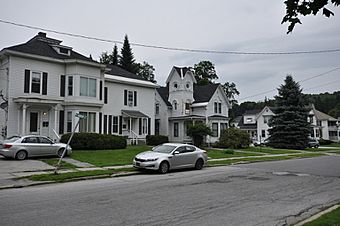Currier Park Historic District facts for kids
Quick facts for kids |
|
|
Currier Park Historic District
|
|
 |
|
| Location | Properties bordering Currier Park on Park, North, East and Academy Sts. and adjacent properties on Averill and Cliff Sts, Barre, Vermont |
|---|---|
| Area | 10 acres (4.0 ha) |
| Built | 1883 |
| Architectural style | Colonial Revival, Italianate, Queen Anne |
| NRHP reference No. | 90001454 |
| Added to NRHP | September 27, 1990 |
The Currier Park Historic District is a special neighborhood in Barre, Vermont. It's known for its beautiful old homes built in the late 1800s. This historic area is centered around Currier Park, a lovely green space created in 1883. Many of the houses here are grand Victorian-style buildings. This district was added to the National Register of Historic Places in 1990, recognizing its importance.
Discovering Currier Park's History
How Barre Grew and the Park Began
In the late 1800s, the city of Barre became very important for its granite industry. People came from all over to work in the quarries and stone processing factories. This made Barre grow super fast! More workers meant more homes were needed.
East of downtown Barre was a farm owned by Stedman Chubb. He was a stonemason who bought the land in 1881. In 1883, Mr. Chubb started to create Currier Park. He gave the park to the city that same year. It was first called Chubb Park, but later it was renamed after his father-in-law, Richard Carrier. The first houses around the park were built around 1885. By 1905, the whole area was filled with homes.
What Makes the District Special?
The Currier Park Historic District includes Currier Park itself. It also has all the buildings facing the park on East, North, Park, and Academy Streets. The district stretches a bit further along Park, East, and Academy Streets. It also includes properties on nearby Averill, Cliff, and Mount Streets. This area is right next to the Barre Downtown Historic District.
Most of the main buildings in this district are in a style called Italianate. This style often features low-pitched roofs and tall, narrow windows. Many other homes are in the Queen Anne style. This style is known for its towers, turrets, and decorative details. There are also four Colonial Revival houses. These were built in the early 1900s and look back to older American styles. The park itself is shaped like a rectangle. It has paths that look like a star and lots of grassy areas with trees.



